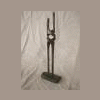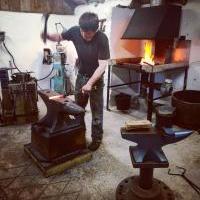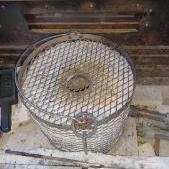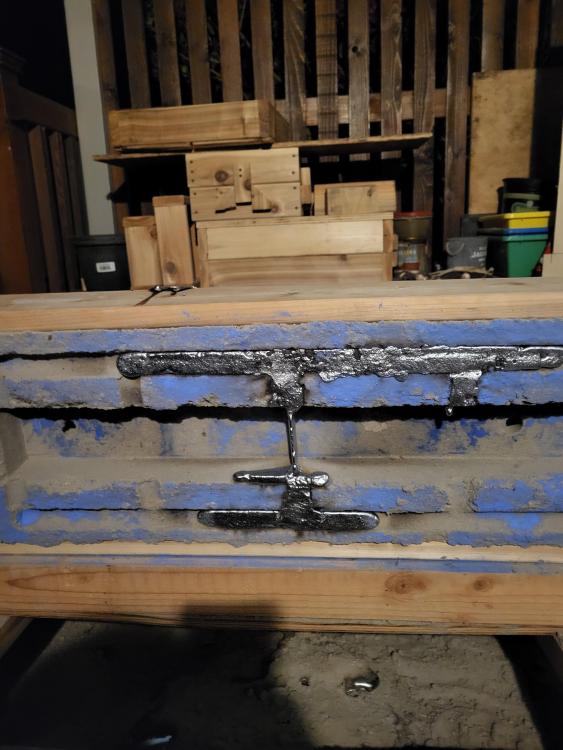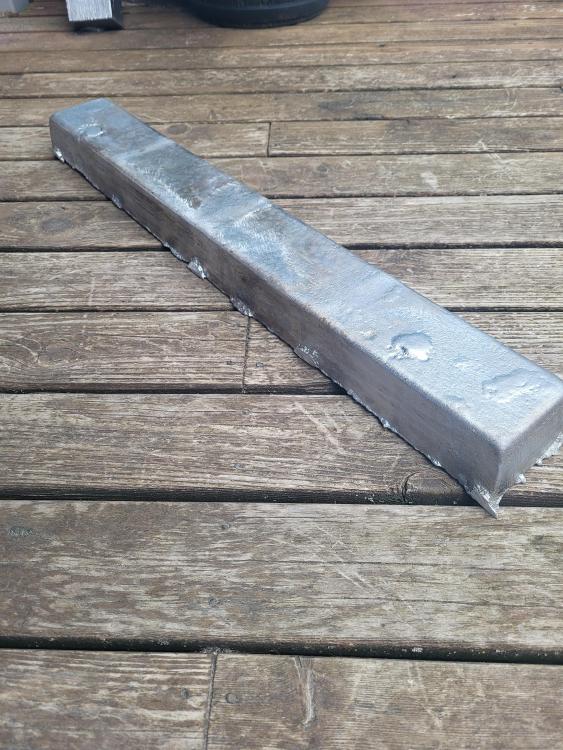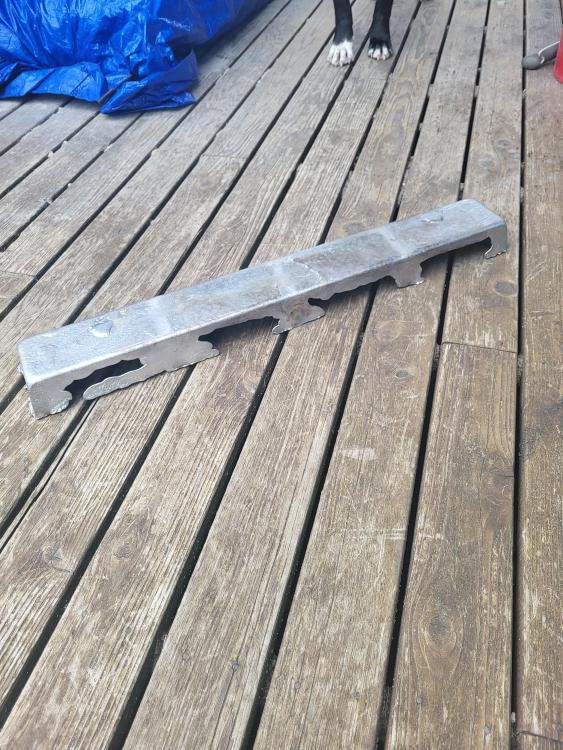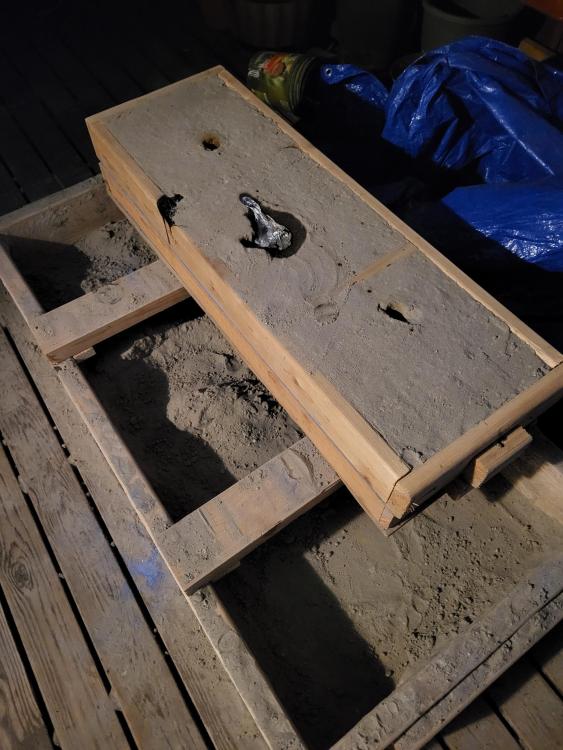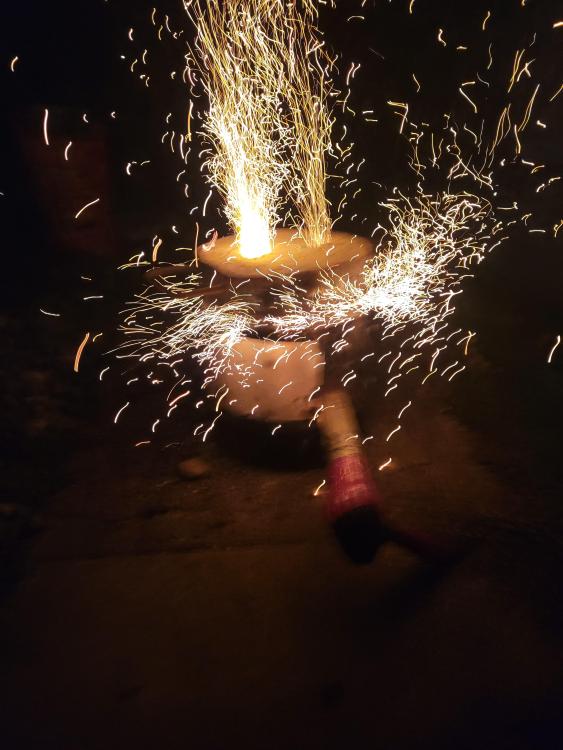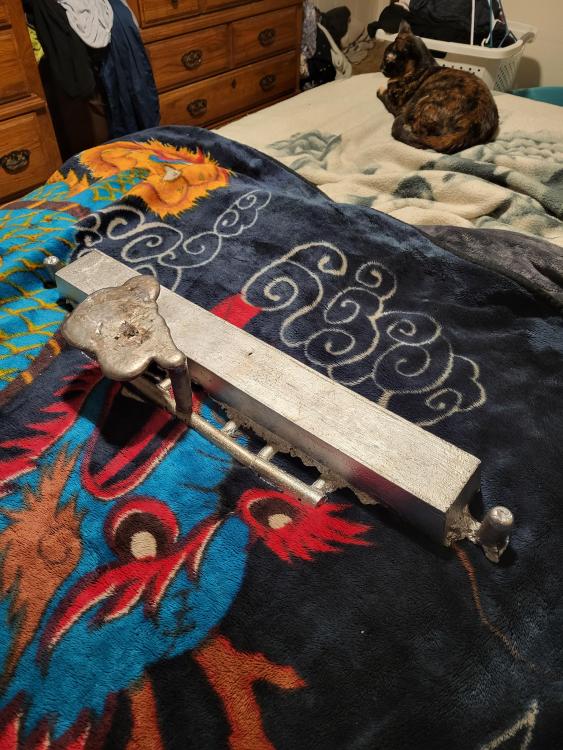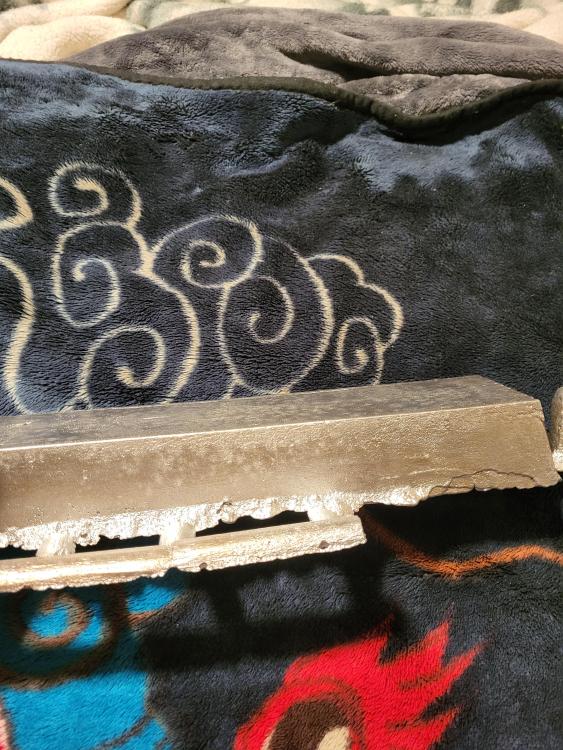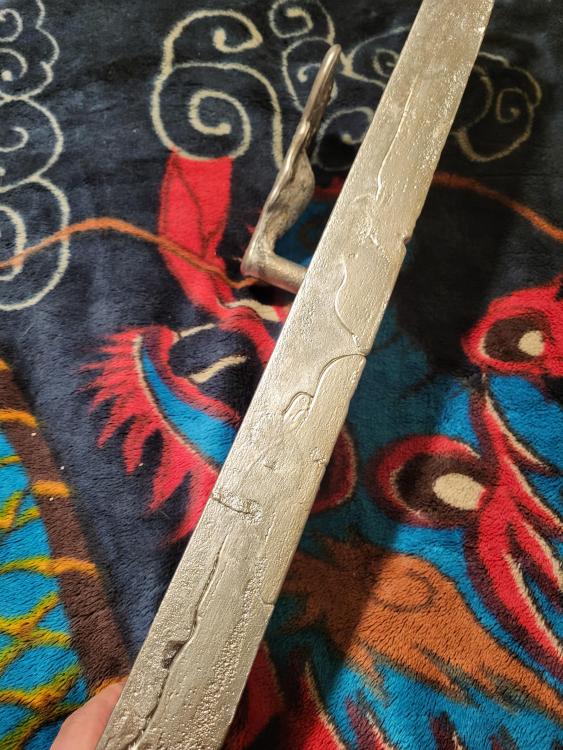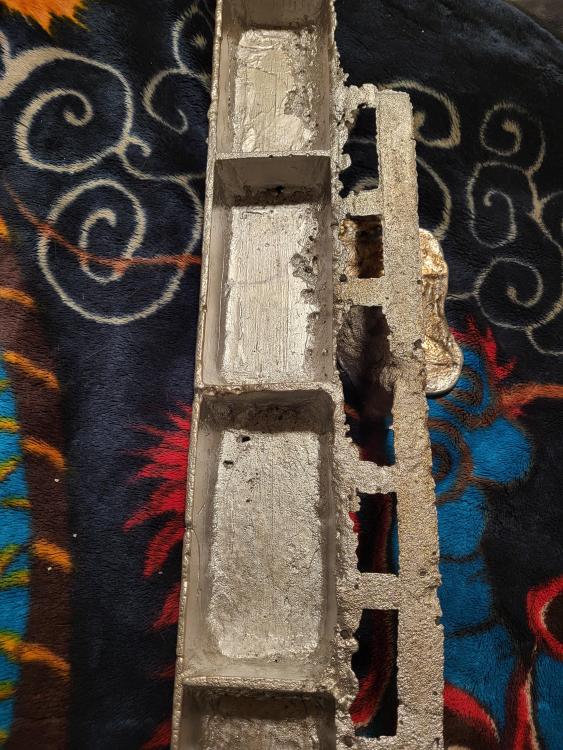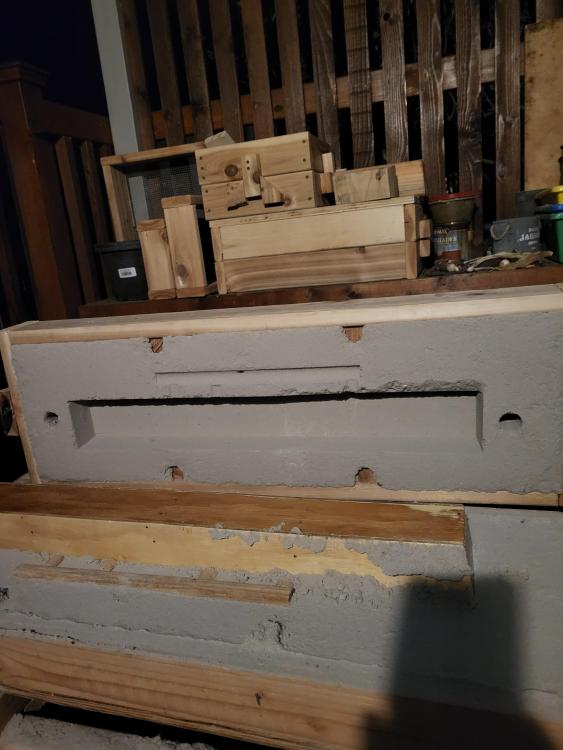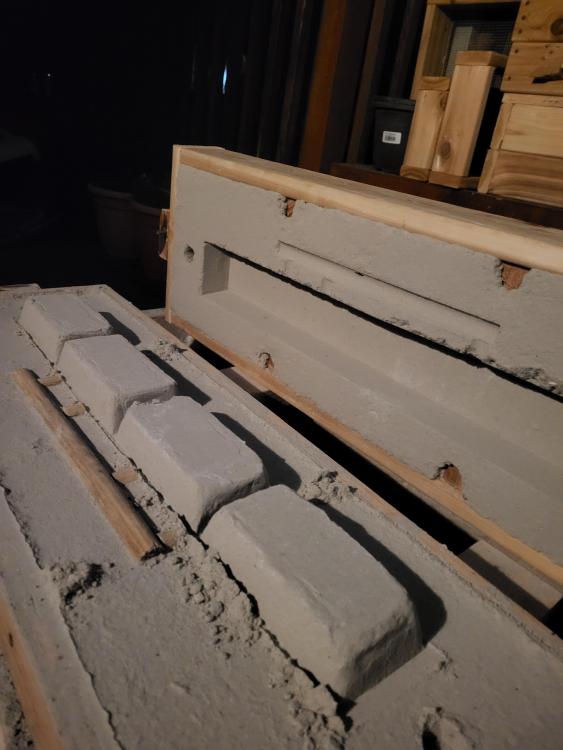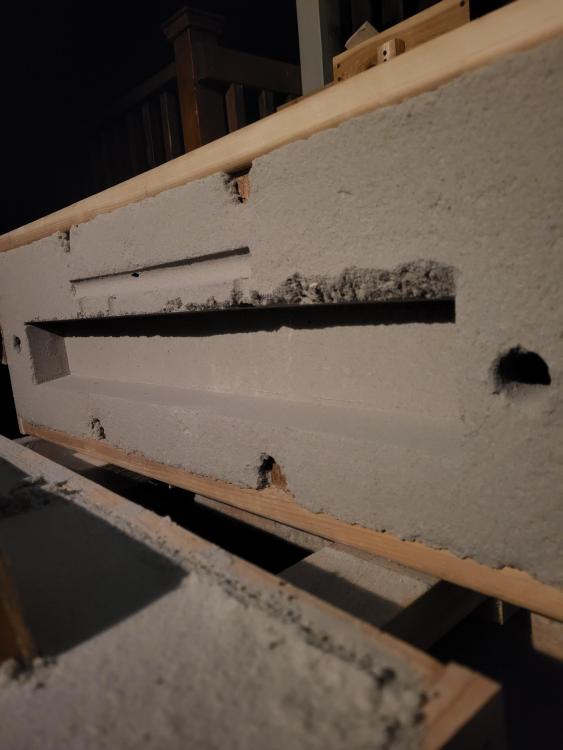-
Posts
1,590 -
Joined
-
Last visited
Profile Information
-
Gender
Male
-
Location
Coupeville, Wa
-
Interests
Smithing, casting, running, almost anything involving historical engineering. A shiny new hobby or bit of knowledge a day practically.
Contact Methods
-
Yahoo
benbaker1976@yahoo.com
Recent Profile Visitors
-
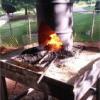
why did my angle grinder stop working
Nobody Special replied to GhostTownForge's topic in Grinders, Sanders, etc
Took mine apart enough to pull the brushes this morning. No bueno. One was reasonably okay, maybe worn down between a third and a half. The other was around a quarter inch shorter, the wear was slanted, and there was a chip missing out of the shorter side. Gotta take it apart some more to get a look at the commutator. That thing is buried in there more than I thought. Turns out nobody local carries bloody carbon brushes either, so I'm ordering a variety pack and making Jeff Bezos a little richer. -

why did my angle grinder stop working
Nobody Special replied to GhostTownForge's topic in Grinders, Sanders, etc
I would tend to think bad connection in the cord, switch, or less likely, the brushes getting a crap connection. Frosty may well be right, but I don't think any of mine have a cutoff for overheating, so I'm not experienced with it. The cord you can jiggle (carefully) to see if it cuts out, or test for resistance. Switch you pull out and test for resistance. Brushes you take out and look at them and while you're at it, make sure the commutator is clean and not scored. And if you've got them out, why not replace them. You can clean a commutator by sanding with a VERY fine grade of sandpaper, lightly, then cleaning out the grooves with a probe or thin screwdriver. I just had an old favorite, a Bostitch start making popping noises once in awhile, acting weak, and getting hot while using the cutting disc, so I'm guessing I've fried the brushes and it's arcing to the commutator (the bit of the armature that the brushes touch). Or maybe some of the carbon has got down in there and is arcing. I'd fix it, even if it costs more than new. I've had that thing for around a decade and love it. You kinda get attached to them. I've got three, one Bostitch, one Dewalt, and an $11 HF Chicago Elecric special that just will not die no matter what I throw at it. I've bought three of the latter over the years, almost more out of morbid curiosity than anything. One lasted about 30 minutes before the windings started smoking, one lasted maybe six months before the brushes went and I gave it away, and the other has been going for maybe eight years now, zero maintenance. It's the Nash Rambler of angle grinders, clunky, awkward, and people look at you funny when you use it, but it just will not die. -

Casting a Gingery Lathe
Nobody Special replied to Nobody Special's topic in Smelting, Melting, Foundry, and Casting
For the incandescence, I checked it with the lights off for a couple of seconds, poured at red, not incredibly dark, but not really sure yet if it wanted to go light red to orange. Say about 1400, and I know that's less than 1500...at least in steel, and I spent a long afternoon once hunting down articles on incandescence - what it looked like at the time is that most materials, and certainly metals glow once you get past about 1000 degrees, with about the same color at similar temperatures. Of course, I've slept since then, and I may have read it wrong, and I certainly wouldn't want to trust that as a method in the daylight, but my little laser pyrometer doesn't go nearly that high, and the texture/resistance also felt right. -

Casting a Gingery Lathe
Nobody Special replied to Nobody Special's topic in Smelting, Melting, Foundry, and Casting
Some updates - The baked cores for some reason expanded and wouldn't fit in the pattern. Who knew? I made a second attempt and screwed up the pour, which was maybe a bit too cold, and the sprue froze/clogged and I get a huge mess. Third attempt - my ramming has gotten much better, I used incandescence to judge the temperature (at night), I've taken to hand packing the cores into the pattern to avoid flipping it, and I added a touch of bentonite to the sand and tempered it a bit further, which helped tremendously...and then I shorted the crucible by maybe 20 ounces or so...bottom of number two, and the aftermath of number three in the pics below. -

What did you do in the shop today?
Nobody Special replied to Mark Ling's topic in Blacksmithing, General Discussion
I don't know ALL the verses, but I can sing Which Side Are You On and the Union Maid drunk, blindfolded, and backwards...and for that matter the regular way. Also, thank you for that ear worm, my wife just asked why I was going around the house singing "Oh Christmas Tree". Sigh... You're right about the sand. Want a weirder fact? They're running out. Different kinds of sand have very different kinds of uses depending on the composition, size, and sharpness of the corners making it up. Sand found say in the desert is no good for construction and cement making because it's rounded off from centuries of exposure and erosion. I don't think this is the article I was looking for, but... The Story Of Sand In 'The World In A Grain' : NPR Or did ya mean the one by Connell to the other tune? -

What did you do in the shop today?
Nobody Special replied to Mark Ling's topic in Blacksmithing, General Discussion
I've seen the gold fever. They get crazy. You can pan for it lots of places. I've found a few flecks embedded in rocks here (Whidbey Island) dropped by glaciers when I was hunting for jasper and agates. An Army buddy (the guy that taught me to make moonshine, before he got kicked out for...go figure, DUIs) had a brother that used to pan streams on their land up near Dahlonega, GA. It wasn't worth professionally mining, and he didn't make much, but he could work four hours a day and make a lot more than flipping burgers. Seems like a lot of the really good mines started by people fixated on gold, or sometimes silver. Come for the gold, stay for the tin, mercury, copper, antimony, bismuth, lead...Bisbee got started that way in the 1800s, and they were taking copper out of the ground until the 70s. They also had that whole thing where they rounded up a few thousand men supposedly for being Wobblies and tried to get the Army to put them in a detention camp, but that's this whole other story. -

What did you do in the shop today?
Nobody Special replied to Mark Ling's topic in Blacksmithing, General Discussion
It was a beautiful failure about 1 lb and a hair shy of having enough metal, but I'm not unhappy about it. The mold rammed up beautifully, lines were lovely, less porosity, no cracks, some shrinkage on the top from it running out of metal. I'd added risers and made the runners and gates bigger, which worked great, but also took up more metal and I didn't allow for enough. It's over nine lbs of aluminum total and need closer to ten in the crucible to be sure. On the other hand I learned a lot more and a lot went right. Got a much better feel for a good temper, my ramming is getting better, venting went well and I've been playing with crossbars and gaggers to hold up the sand in the long stretches. And since I cast at night, I could tell the pouring temperature by the incandescence. I'm worn out now from moving dirt for my wife, but I'll put a pic in the gingery lathe post later. -

Is this slag?
Nobody Special replied to Ridgeway Forge Studio's topic in Smelting, Melting, Foundry, and Casting
Sure looks like slag of some type. Are you near a current railroad? You also tend to find thermite slag where they weld rail in, and it looks, well, a lot like that. I used to bring bits of it home from work once in awhile. -

What did you do in the shop today?
Nobody Special replied to Mark Ling's topic in Blacksmithing, General Discussion
It took three times ramming the mold up and 4 hours of time, but after all that, but finally got another good mold and made an attempt at casting a lathe bed. And for all that sweat and tears, I have all this to show for it. Oooh...ah....and then you wait for two hours to open it and see if it came out right. Should know in another 15 minutes-ish. Isn't casting exciting? Now I remember why I switched to forging... I like the wheels, btw. -
I think the welds fit in fine. I like the patina on the face especially.
-

What did you do in the shop today?
Nobody Special replied to Mark Ling's topic in Blacksmithing, General Discussion
-
Well, yes and no. Apparently, some of the copper ore they would pull out of the ground in Germanic deposits wouldn't reduce to metal no matter what they threw at it. Turns out it was mostly nickel and arsenic with a little copper for good measure. Supposedly some of them thought the ore to be cursed somehow by whatever you call the German version of tommyknockers. So both the ore, and the potential goblin were nickels and when they finally isolated the metal... The needle bit was cool too. Oddly enough, they're not made singleton, but two at a time. The rod is cut, ground on both ends, then stamped in the middle, punched, broken apart, cleaned up, tumbled, sometimes finished in other metals or anodized or dipped in gold to make the eye stand out. Pins are similar, but apply molten glass. Like I said, took me a long-time taking side trips to watch videos on the open-hearth process, lead creep, needle making, the use of platinum leads in older style light bulbs to avoid breakage through different coefficients of expansion...you get the idea.
-
I recently picked up a copy of Metals in the Service of Man (Alexander and Street, 1958). There are more recent versions, but I didn't have $111 to spend on it, so I read the 1958 version. It's dated and the plot is a bit slow, but it's a surprisingly good read for a version of a book that's almost seventy years old. I wouldn't recommend it as the final word on metallurgy - for example it hadn't quite figured out titanium and talked about the open hearth process of producing steel as one of the contemporary leading methods. But for all that, it had a nice beat and you could dance to it. The general descriptions of metallurgy worked, if they weren't quite complete, and there were lots of interesting tidbits on the physical properties of iron and alloys, plus occasional bits of trivia such as the influence of metal production on the German goals in WWII, or explaining how the metal nickel took its name from the word for devil (incidentally, pumpernickel literally means farting demon, because rye bread tends to lead to flatulence). I would love to read the 1998 version if the price ever comes down or I can get an inter-library loan, and it would well be worth a read to someone looking to learn about metallurgy in general, including iron and its alloys. P.S. You may find yourself on some interesting internet side-trips, such as one I took to look up the production of steel needles, which was a lot cooler than it sounds and matched the book's description almost perfectly. Alexander, W. & Street, A. (1958). Metals in the Service of Man. Pelican.
-

Casting a Gingery Lathe
Nobody Special replied to Nobody Special's topic in Smelting, Melting, Foundry, and Casting
The aluminum gods did not smile, although they nearly cracked a sardonic grin. It looked gorgeous when I opened it up...and then not so much. The first attempt got minor washes and runs in the front...almost good enough, but a little bit of misfeeding. The top has one small inclusion and a shallow concavity about the size of a silver dollar from shrinkage in one spot. The back is a mess of hot tears though from it shrinking, but only on the one side. The interior also had rough sections on one end, probably trapped gas. On the plus side, I got a LOT of practice making molds and patterns and learned a good bit about handling it. I know how much metal it needs (just over a quart and a half), and I think I know what I screwed up...metal not hot enough and the risers needed to either sit behind or on top of the pattern. I was surprised that despite the cracks in the back the shrinkage was much less than I expected. The final piece was maybe a third of an inch shorter than the pattern, if that. If I try again and it fails, I may also make cores with a molasses binder and bake them hard. It would make things easier and I wouldn't have to roll the mold. -

Casting a Gingery Lathe
Nobody Special replied to Nobody Special's topic in Smelting, Melting, Foundry, and Casting
Finished the new pattern for the bed, rammed it up...and a quarter of it fell in. Did it again...same result, on the other side. Moved the risers, rammed it up...and it fell in again. (turns out the ribs that Gingery suggested for the cope (top part) make a weak point because they don't go all the way down). Then I got smart. Gingery originally has you put the cope on a board, right side up with the pattern in it, ram up the mold over the outside, then flip it over, put the drag (bottom part) on, and ram the sand in it AND the cores for the inside of the pattern, still in the cope. Then you roll it over one last time, take the cope off, and pull the pattern off of the cores before putting it back together. It's brilliant, but it kept falling in, no doubt from me varying from his sizes and putting risers on it. Then I got smart...I figured the whole reason for flipping it over so much was to create the cores...but when the top fell in, the cores were still inside the mold and perfectly good. So instead of starting from scratch, I rammed the top, which put less stress than ramming it over and flipping it twice...and part of the mold stuck to the pattern. (see attached pics). Dang it. Today, I cut the side of the ribs short, and only had the top fall in once before getting it right. I think if I'd added some kind of support at the bottom under the ribs, it would have survived flipping, but I got it when I left the bottom alone and re-rammed the top like last night. Poured 1.5 hours ago...waiting to break it open and see if the aluminum gods have smiled on us.

